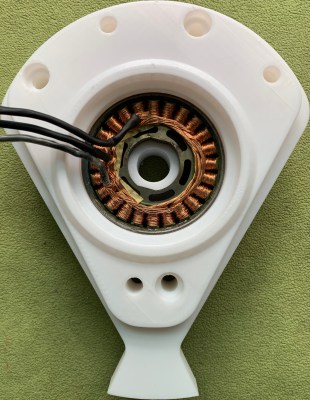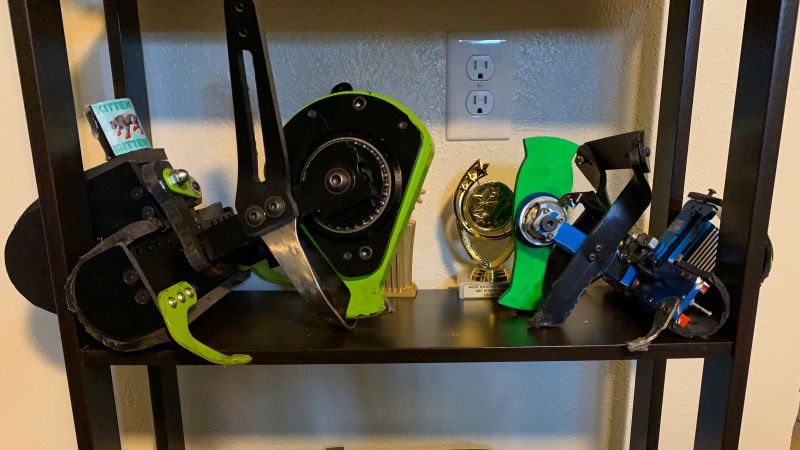If you watch it on TV or see clips on YouTube, you’ll notice that most combat robots have wheels, which would make sense. They are simple, work well, and if designed right they can take a bit of a beating. So why did [Luke] design his 12-pound bot with no wheels, or any locomotion system for that matter? You can find out more about this peculiar bot in his build report with more than 130 images.
[Luke’s] bot, called Kitten Mittens, is a gyro walker combat robot. This means that instead of traditional tank treads or wheels to move about, [Luke] navigates by angling his bot’s weapon and using the angular momentum to lift up one side of the bot to “walk” forward. Watch the video after the break to see it in action. While this does leave Kitten Mittens much slower and less agile than competitors, it gives one massive leg up; weight. Kitten Mittens fights in the 12-pound combat robotics weight class, but most leagues have weight bonuses for bots that have no wheels or use otherwise nontraditional locomotion. Where [Luke] competes, the Norwalk Havoc Robot League, this means that his bot can be up to 6 pounds heavier than the other competitors!

So how did [Luke] take advantage of that extra 6 pounds? The biggest thing was the weapon. It is made of 3/4-inch S7 tool steel and has a custom hub motor integrated into the center, bringing its rotating weight to 5.5 pounds. In addition to thickness, the added weight allowance permitted a larger spinning diameter so that Kitten Mittens could hit opponents before they hit him.
[Luke] is not new to the world of combat robotics, and knew it would take more than just a big weapon to win. Part of the extra weight budget was also used to beef up his armor and internal structure of the bot, so that hits from opponents would just bounce him around the cage harmlessly. This even included custom bent titanium guards surrounding the weapon, to help in self-righting.
When it first debuted in February of 2021, Kitten Mittens was a smashing success! It went 4-0 in the 12lb weight class at NHRL, winning the $1,000 prize and earning its spots in the annual finals, where [Luke] will compete against other finalists from the rest of the season for a chance to win the $12,000 first-place prize.
Bots that walk, shuffle, or crawl are becoming more of a trend lately in all weight classes. Even Overhaul, a 250-pound bot, has been given a new set of feet to shuffle around on. You can read more about this interesting concept here.
















not sure it would do any good but the bout in the video makes an interesting case for autonomous countrol. the flat robot seems fast enough to circle KM and always attack from the rear, but the pilot isn’t skilled enough. it would really require a pretty amazing investment of effort but i could imagine a super-human control system capable of reliably keeping the flat one behind KM. not sure if the effort would pay off against too many other kinds of opponents though…it would really quickly become a different kind of competition.
https://www.youtube.com/watch?v=QCqxOzKNFks for a nice compilation of autonomous fightin’ robots.
Two types of robots that can be devastating if the driver practices to be effectively offensive are thwackbots and bots with a big hammer. Unfortunately what I’ve seen in watching a large amount of robot fighting on TV and youtube is hardly anyone who enters those types of bots has any sense of timing on when to attack.
Thwackbots mostly end up spinning ineffectually and flailing back and forth, beating up the arena floor, then eventually getting their wheels damaged so much they can’t move, or ripped off, sometimes along with the drive motors.
Drivers of bots with big hammers mostly seem to freeze up when their opponent is right in front of them in ideal position to be pounded. By the time they (or their weapon co-driver) gets around to flipping the switch, pushing the button, or pulling the trigger, the opponent has moved out of the way and the hammer pounds into the arena floor.
The most aggressively and successfully driven hammer bot was Grant Imahara’s middleweight Battlebot “Deadblow”. It scored a record for number of hits in the original Battlebots series, but did little damage.
What has become the two most effective types of bots are the vertical axis horizontal bar spinners like Tombstone and the horizontal axis vertical drum spinners like Copperhead. Chunky disk spinners like Kitten Mittens and several others also do quite well though their higher mounted spin axis can cause issues.
There have been a few extremely powerful, high speed flipper bots that have had success, but only if they also have high movement speed, very good maneuverability, and a driver able to use those capabilities to get the flipper under the opponent, away from its weapon, and immediately hit the flipper to fling the other bot, hopefully making it land hard enough to make it damage itself or where possible get it out of the fighting area. But I’ve seen most of those fall to skillfully driven spinning weapon bots like Tombstone.
What I’d like to build for a fighting robot is one with a heavy hammer that’s spring powered. The hammer system would use a pair of very heavy springs, compressed with a pair of winches. It would start the match with both springs compressed, but only one spring at a time would drive the hammer. A third winch would pull the hammer back after it fires, upon which it would engage the second spring. Immediately after firing, each spring’s winch would start compressing it. From the start, the bot could do one hit with a fast follow up. Subsequent hits would be slower between them unless it could get both springs compressed.
To make it more effective I’d put a pair of hardened steel wedges out the front, with sharp edges on top, UHMW on the bottom surfaces so they could slide on the floor, and slightly up turned tips to reduce snagging on floor damage. On the front of the bot’s body would be a bumper that triggers the hammer so there’s no relying on human reflexes to fire. Ram. Click. Hammer. Opponent bot given a three point crush, like that scene in that movie where the mob enforcer put a guy’s arm on a pair of support cradles then hit it with a baseball bat.
I’d call it “Clickbait”.
Ancient thread
… but if you ever build it, have your trigger fail “safe”, unless you have a button pushed on your remote. Thus, as you approach, if you’re pretty sure you’ll have a good shot, hold down the button. But if you think something is going to trigger a false shot, hold off.
I’m not sure it could be that agile in effect – its fast enough to stay out the way, but not I don’t think to ever circle that scary kitten – as when that thing needs to it really tilts the gryo over and twists rater fast – in the process perhaps the thinness of the Frog could actually get under the big weapon as its tilted so far, at least for a moment…
Really not sure at this weight how you could kill the Kitten, seems like the only way to really disable it is take the little feet it pivots on out, or be tough enough its own weapon does more harm to itself than you..
Use a flamethrower like some battlebots have burn it.
Years ago, I recall reading an article in a trade rag about genetic algorithms being used to improve jet engines. If I recall correctly, hundreds of physical attributes of various engines were quantified and assembled into a parameter tables…the engines’ DNA, if you will. Then, using software, different engines were “bred” to create engine offspring. The same selective breeding techniques used in your typical dairy farm were applied, and the result was the creation engines with improved performance and fuel efficiency.
Hypothetically, it should be possible to do the same with battle bot designs– numerically quantify all of the aspects of a battle bot…speed, wheels, legs, relative complexity, stability, control, weight, size, power consumption, self-righting capability, armor, weapons capabilities (rotational kinetic, puncture, flame, impact etc)— and then “breed” them.
One wonders what kind of apex monster could be created!
Eventually battlebots will end up like main battle tanks where they all look almost the same, because the engineers figured the optimal design for them
Even now the bigger battle bots look rather similar. fast, Low, heavy and well armored. They either have a nasty hammer, buzz saw or flamethrower and a flipper as well.
Also who is controlling the battlebot is critical. Some guys are just wizards at it and can really get the most from the bot.
A bit too rock, paper scissors to really create a single super bot concept, too many mutually exclusive (within the rules as I understand them) options – there is a reason armies still have people, helicopters, light/scout vehicles/tanks, fighter bombers, etc – your MBT is a great machine, pretty versatile on the ground, but it isn’t able to deal with all threats effectively. There is also a reason why things like Cesna and Pickuptrucks with machine guns have been used – your MBT is too slow, expensive, each shot costs to damn much and actually quite vulnerable (at least to some things) its just not the right tool for every job, and even tools that seem almost like jokes actually perform some roles better.
Within the rules – mostly the weight limit you are always going to have a variety of robotwars bot concepts optimised for one thing or other.
That’s an interesting concept
What would your error function be though? Multi-objective Genetic Algorithms HAVE been used in combat robot design, and a member of Team Minotaur wrote a paper on having a system design a drum weapon! https://web.archive.org/web/20170829194543/http://web.mit.edu/jlramos/www/Arquivos/RioBotz_Drum_GA.pdf
That is one cool robot! maybe the best robot ever made!
Shhhhh! Skynet is listening!
(Or it will scan Internet archives in the near future)
B^)